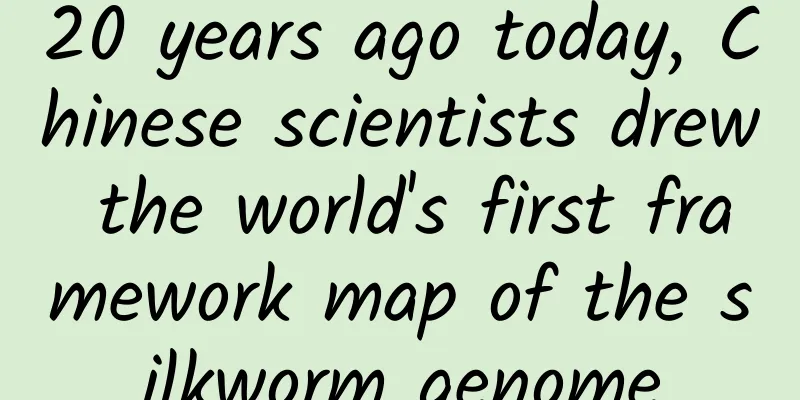20 years ago today, Chinese scientists drew the world's first framework map of the silkworm genome

|
On November 15, 2003, Chinese scientists completed the world's first silkworm genome framework map using shotgun sequencing. This is the third major genome research achievement contributed by Chinese scientists to mankind, following the completion of 1% sequencing of the human genome and the framework map and detailed map of the rice genome. The world's first framework map of the silkworm genome More than 200 yellowed manuals record research records starting from the 1940s, and more than 700 silkworm genetic systems have been established so far... At the State Key Laboratory of Silkworm Genome Biology of Southwest University, sericulture genetic breeding expert, Chinese Academy of Engineering academician Xiang Zhonghuai and his mentor Professor Jiang Tongqing led a team to establish the world's largest silkworm gene resource bank. It is on this basis that the team has bred a number of high-quality and high-yield silkworm varieties, some of which are still widely used today. There is also a special "treasure" in the laboratory - a scroll several meters long, with a number of groups of red and blue barcodes of different lengths arranged on it. This is the world's first high-quality framework map of the silkworm genome. "The mysteries of all kinds of life are hidden in the base sequence of genes." Facing this framework diagram, Xiang Zhonghuai said with deep emotion that the silkworm has great similarities with humans in basic life system, energy metabolism and inheritance mode. It is also an internationally recognized model insect of Lepidoptera, and 70% of agricultural and forestry pests also belong to Lepidoptera. Therefore, the research on the silkworm genome has a far-reaching impact on the development of new silk industry, biopharmaceuticals, agricultural and forestry pest control, and medical biology. The international competition for silkworm genome research has actually started long ago. Japan, which was the world leader in silkworm industry in the 20th century, unilaterally terminated the original China-Japan cooperation agreement in March 2003 and independently started silkworm genome sequencing. Faced with this severe international competition, Xiang Zhonghuai decided to fight hard, "Genome research is the foundation for improving academic level and industrial development. Whoever seizes the commanding heights will be ahead in everything." In early June 2003, the team moved into the Beijing Genomics Institute, and the two sides urgently launched the silkworm genome sequencing project. "Everyone worked more than ten hours a day on average, eating boxed lunches, sleeping on the floor, and fighting continuously. Later, many people became sick from exhaustion." Recalling the situation at that time, Xiang Zhonghuai's eyes moistened. On August 25, the team completed 5.5 million sequencing reactions five days ahead of schedule; on October 7, the assembly and splicing were completed... After more than 400 scientific researchers worked day and night for more than 150 days, on November 15, the Chongqing Municipal Government held a press conference to announce that Chinese scientists had completed the world's first framework map of the silkworm genome. Starting point and milestones of the "21st Century Silk Road" According to bioinformatics analysis, there are about 20,000 genes in the silkworm. Chinese scientists have obtained 16,948 complete genes and 7,285 gene fragments through shotgun sequencing, of which about 6,000 genes are newly discovered. The research team has also obtained a number of theoretical results of great value in the structural characteristics of the silkworm genome, the organization, evolution and comparative genomics. The results of computer assembly and data analysis show that the genome sequencing has completed a coverage depth of 6 times, and the obtained sequence covers 95.54% of the silkworm genome, with an accuracy of 99.95%, which fully meets the requirements of a high-quality working framework map. China is the birthplace of the world's silk industry. At present, with modern technology as the core and genome research as the platform, starting from the silkworm, finding and building a "21st Century Silk Road" with breakthroughs in silkworm technology, eradication of lepidoptera agricultural and forestry pests, and development of biological medicines as the main content has become a consensus among sericulture scientists from various countries, and fierce international competition has been launched for this purpose. Xiang Zhonghuai said: "my country was the first to publish the first silkworm genome framework map to the world, which means that my country has taken the lead in the world in silkworm genome research and is also the starting point and milestone for the establishment of the '21st Century Silk Road'." The silkworm genome has 450 million base pairs, which is about one-seventh of the human genome and slightly larger than the rice genome. However, researchers completed all the work from cDNA library construction to sequencing and assembly of framework maps in just over five months, setting a record for the fastest genome research. It also optimized genome sequencing technology, greatly reduced research costs, and improved the quality and accuracy of framework maps. It took several years to analyze the "Thousand Silkworm Genome" The silkworm is an important economic insect and an emerging model organism, but previously there was only a single reference genome and partial resequencing, which was not enough to support the in-depth mining of genome variation and excellent genes, especially for molecular breeding. Therefore, it is particularly important to digitize the genome of silkworm germplasm resources and build a super pan-genome map of silkworm. Since the silkworm genome framework map was completed in 2003, the scientific community has been continuously conducting sequencing research on the silkworm genome, hoping to draw a more complete and in-depth map. However, the number of samples in previous silkworm population genomics research was only dozens or more than 100, and they were all based on second-generation sequencing technology, with short sequencing reads, few samples, and limited information obtained. With the maturity of third-generation sequencing technology, pan-genome research has become possible. Professor Dai Fangyin, director of the National Key Laboratory of Silkworm Genome Biology and chief scientist of the National Sericulture Industry Technology System, and his team spent four years conducting deep sequencing of 1,078 silkworm germplasm resources, and drew the world's first super pan-genome map of the silkworm. "These 1,078 silkworm germplasm resources cover the major silkworm areas along the 'Silk Road' and more than 90% of the world's representative silkworm germplasm resources. The sample size is large and the coverage is wide." Dai Fangyin introduced that this "Thousand Silkworm Genome" includes 47 wild silkworms, 205 local species of silkworms, 194 practical species and 632 mutants. The project sequenced more than 1,000 samples, of which 545 representative resources were sequenced for the third generation, and 545 high-quality silkworm genomes were assembled, obtaining the most extensive genetic variation information of silkworms. This super pan-genome includes the most comprehensive genome information of silkworms and wild silkworms, is the largest long-read pan-genome in the world's plants and animals, and is also the highest-quality silkworm genome map. "The completion of the silkworm super pan-genome will break through the bottleneck of silkworm breeding and usher in a new era of silkworm molecular breeding." Xiang Zhonghuai pointed out that this is the greatest achievement in silkworm research in the past century. It has enabled sericulture to enter the information age, opened a new chapter in silkworm functional genomics and molecular breeding research, and is a new starting point for scientific and technological support to revitalize the silk industry. With this "digital dictionary" of the silkworm genome, the team conducted in-depth research on various genetic variations, population structure, artificial selection, ecological adaptability, and economic traits of the silkworm, and many mysteries of silkworm research were solved. |
Recommend
Guangzhou Hairstyle Design Mini Program Function, How Much Does It Cost to Make a Barber Shop WeChat Mini Program?
“The head can be cut off, but the hairstyle canno...
Yuanfudao Product Analysis
How did Yuanfudao, which has only been establishe...
Direct-operated e-commerce information flow advertising strategy
When the Internet becomes a traditional industry,...
WeChat is fighting with Alipay, who is the king of B-side?
[[273439]] Recently, there was a piece of news th...
8 minutes to help you quickly understand data analysis (with book recommendations)
With data analysis being so popular in the past t...
The pineapples on the tables of European nobles were once rented
For someone who likes pineapples, even if the pin...
China Automobile Dealers Association: Auto dealer inventory warning index is 52.5% in October 2021
On October 31, 2021, the latest issue of the &quo...
Is it true that the national average daily number of inbound arrivals is 120,000? Pay attention to these travel precautions!
At present, the epidemic situation in our country...
Among the companies in Zhuzhou that develop mini programs, which company is more reliable in developing mini programs in Zhuzhou?
Among the companies in Zhuzhou that develop mini ...
How do Huizhou merchants make profits through mini programs? How can individuals make profits by developing WeChat mini-programs?
WeChat mini programs are business opportunities i...
World Hypertension Day | If blood pressure drops, can you stop taking medication? 10 myths about hypertension are dispelled today
Hypertension is a common and frequently occurring...
6 suggestions to create an operational promotion plan that can be implemented!
Whether you are a novice in website operation or ...
There is a "sausage" in the universe? It's hundreds of light years long!
Your browser does not support the video tag Autho...
Technology News丨my country's easternmost high-speed railway will be officially opened tomorrow; Omicron "super-spreading event" occurred in Norway
【Today’s cover】 December and March are the best t...
Detailed explanation of the order design model in the e-commerce platform!
As a business subsystem, the order system is very...









